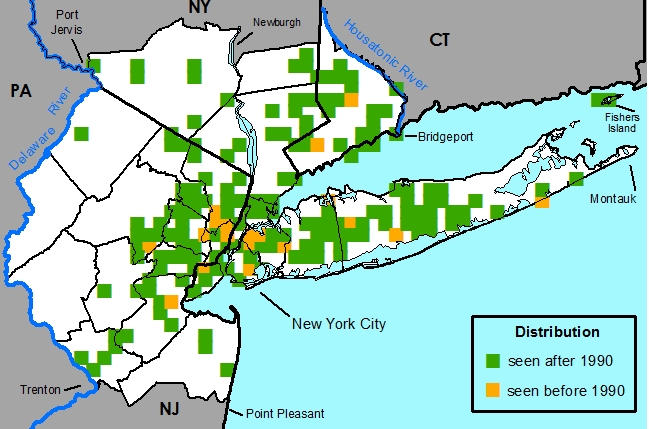Frangula alnus Mill. - Smooth Buckthorn
Non-native , Frequent
By Steven D. Glenn
Not peer reviewed
Last Modified 02/06/2013

Common Names
Smooth BuckthornField Identification
Upright shrub with simple, alternate, toothless leaves with globose fruits.Other uses
(Rehder, 1940) (Flint, 1983)This species is used in landscape plantings, especially the cultivar 'Columnaris' and is hardy to USDA zone 2?-4.
Poisonous properties
Disclaimer: The information provided here is for reference and historical use. If you believe you have been poisoned, please contact the Poison Control Office near you (look for the number in the front of the phone book).
Ingestion of fruits or leaves can cause mild to moderate nausea, vomiting, and diarrhea; death is unlikely.
Stories
This species is an alternate host to the crown rust disease of oats, it should be avoided or eradicated in areas where oats are grown; and is prohibited by quarantine laws from many areas where oats are grown, especially in Canada.
Nomenclature
Frangula alnus Mill., Gard. Dict. ed. 8, F. no. 1. 1768.
Rhamnus frangula L., Sp. Pl. 193. 1753.
Rhamnus pentapetala Gilib., Fl. Lit. Inch. 2: 131. 1782.
Rhamnus nemoralis Salisb., Prodr. Stirp. Chap. Allerton. 139. 1796.
Frangula alnoides Gray, Nat. Arr. Brit. Pl. 2: 621. 1821.
Frangula vulgaris Borkh., Theor. Prakt. Handb. Forstbot. 2: 1157. 1803.
Frangula frangula H. Karst., Deut. Fl. 868, fig. 496, 9-16. 1882.
Rhamnus frangula var. genuina Rouy in Rouy & Foucaud, Fl. France, 4: 172. 1897.
*Rhamnus Korolkowii Hort. ex Rehder, Man. Cult. Trees, ed. 2, 604. 1940, pro syn.
TYPE: unknown
Description
HABIT Perennial, deciduous, phanerophytic, shrub, monoclinous, 1-6 m tall.STEMS Main stems ascending or erect, round. Bark smooth, gray, not exfoliating. Branches erect or ascending. Twigs dark brown or gray, terete, 1.5-4 mm in diam., smooth and usually with prominent white lenticels; with short and unbranched hairs or with long and unbranched hairs, erect or appressed or spreading, moderately densely distributed throughout. Pith white, round, continuous, nodal diaphragm absent. Sap translucent.
BUDSTerminal and axillary present, scattered along stem. With long and unbranched reddish orange appressed hairs, densely distributed throughout. Bud scale scars not encircling the stem. Leaf scars crescent-shaped, somewhat raised. Vascular bundle traces 3.
LEAVESAlternate, simple, 1 per node, crowded toward stem apex or spaced somewhat evenly along stem, divergent from stem. Stipules present, lateral, deciduous, free from the petiole, scale-like, minute. Leaves petiolate, petiole terete, 0.8-3 cm long, with short and unbranched or with long and unbranched erect or spreading hairs, sparsely or moderately densely distributed throughout; not glabrescent. Leaf blades: abaxial surface light green, adaxial surface green, oblong or obovate, bilaterally symmetric, 2.5-9 cm long, 2-5.5 cm wide, membranaceous, base acute or cuneate, margin entire or ciliate, apex acuminate or acute, abaxial surface with long and unbranched erect or spreading reddish orange or white hairs, sparsely or moderately densely distributed along midveins. Adaxial surface glabrous or with short and unbranched erect or spreading hairs, sparsely distributed along midveins. For a review of the anatomy of the leaves see Gemoll, 1902;Herzog, 1903(in German).
INFLORESCENCES Sertotinous, bisexual, simple, axillary fascicles. Pedicels 3-5 mm long, glabrous or with short and unbranched or with long and unbranched erect or spreading reddish orange or white hairs, sparsely or moderately densely distributed throughout.
FLOWERS5-merous, perianth of two whorls, fragrance absent. Calyx actinomorphic, of free sepals, deciduous, lobes white to light yellow. Sepals 5, narrowly triangular or triangular, 1.5-2 mm long, margin entire, apex acute, abaxial surface glabrous or with short and unbranched erect or spreading reddish orange or white hairs, sparsely distributed throughout, adnate to top of hypanthium. Corolla actinomorphic, of free petals, deciduous, abaxial and adaxial surfaces light yellow. Petals 5, clawed, very widely obovate, 1-1.3 mm long, margin entire, cleft, abaxial surface glabrous, adnate to top of hypanthium. Gynoecium syncarpous, carpels 2. Ovary superior, glabrous. Placentation basal. Stamens 5, enfolded by petals. Filaments white, glabrous. For a review of the morphology of the petals and pollen see Bennek, 1958(in German).
FRUITS Drupe, black, ovoid, 6-8 mm long, 6-8 mm wide, glabrous.
SEEDS 2 or 3, dark yellowish green or black, lenticular, 6 mm long, 5-6 mm wide, glabrous, smooth, abaxial side with groove; with a terminal ligher-colored knob.
Habitat
Moist to dry woods, thickets, fields, and roadsides; also swamps, pond and lake shores and stream banks.Distribution
Indigenous to Eurasia and North Africa, now naturalized throughout the northeastern and midwestern United States and adjacent Canada.
United States -- CO, CT, DE?, IA, IL, IN, KY, MA, MD, ME, MI, MN, NE, NH, NJ, NY, OH, PA, RI, TN, VA?, VT, WI, WV, WY
Canada -- MB, NB, NS, ON, PE, QC
New York Metropolitan Region -- Nonnative, throughout the metropolitan area.
Rarity Status
Heritage global rank -- G5Species Biology
FloweringMyophily, Melittophily, and possibly Cantharophily Probably pollinated by various species in Hymenoptera (Apidae, Andrenidae, Eumenidae?, Tenthredinidae?) and Diptera ( Empidae, Syrphididae, Tachinidae, Sarcophagidae, Muscidae, Cordyluridae, Anthomyidae) and perhaps Coleoptera
Endozoochory -- by avian frugivores: Loxia curvirostra (Red Crossbill), Sturnus vulgaris (European Starling), Turdus migratorius(American Robin), Bombycilla garrulus (Bohemian Waxwing), Bombycilla cedrorum (Cedar Waxwing), Pheucticus ludovicianus (Rose-beaked Grosbeak)
Hydochory? -- Fruits of Rhamnus reported to remain buoyant for several days.
Natural germination usually occurs in the spring following seed dispersal. Germination is hypogeous. This species probably has embryo dormancy which can be overcome somewhat by stratification in moist sand at 41 degrees F for 60 days.